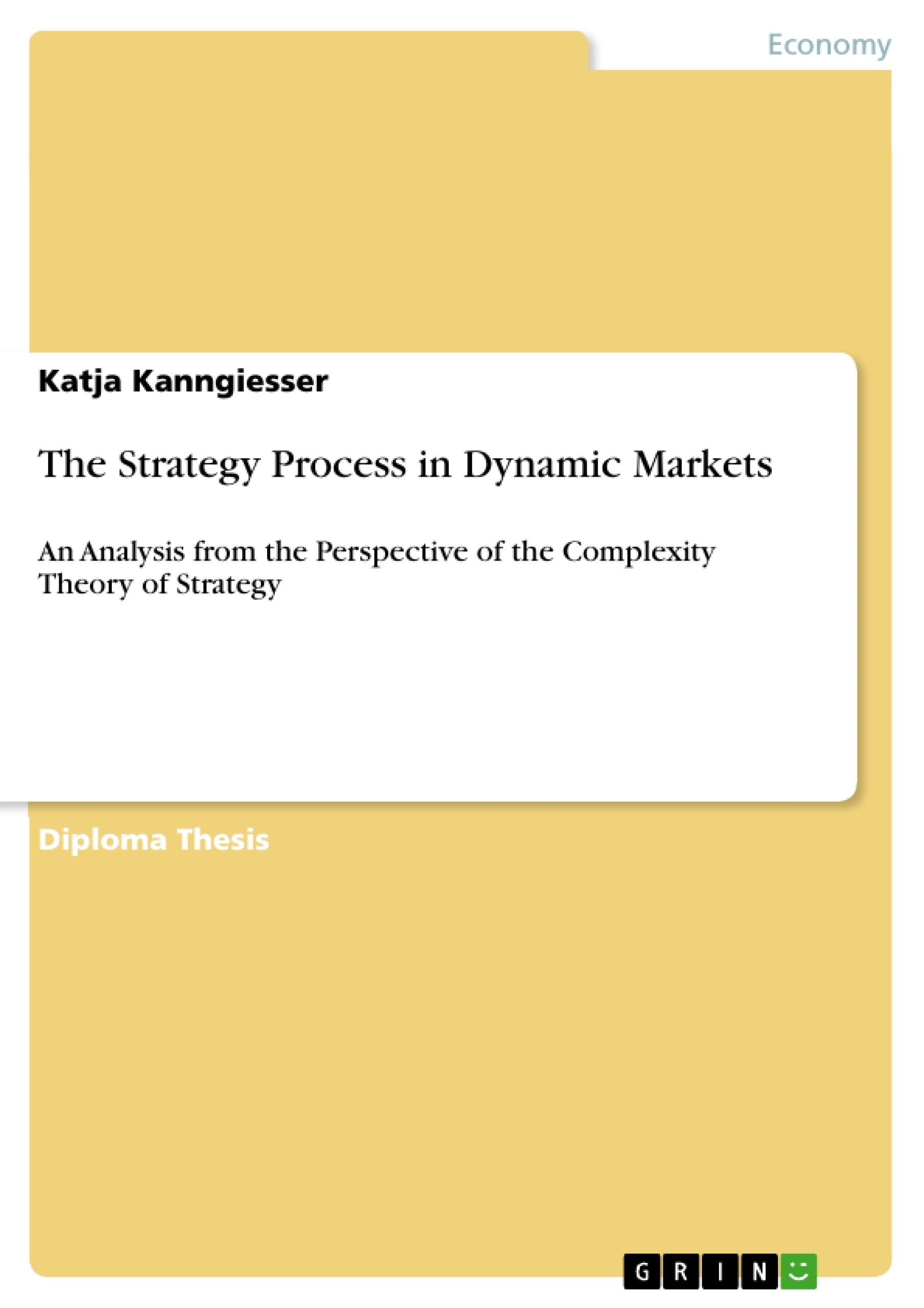This paper is picking up a combination of three perspectives on strategy that are trying to perform a shift of paradigm towards a new way of strategic thinking serving as the basis for a strategy process in dynamic markets. The combination of these three perspectives has been termed the complexity theory of strategy by Davis and Eisenhardt. This theory combines Austrian economic thinking, the dynamic capabilities view, and complexity theory. Austrian economics perceive markets as a rapid flow of heterogeneous and surprising opportunities that need to be captured by strategic managers. The dynamic capabilities perspective perceives organizational resources as simple capabilities that enable quick, flexible, and creative improvisation to respond effectively to this rapid flow of opportunities. Complexity theory perceives organizations and the economy as simple systems, which produce complex and adaptive responses to environmental change. The complexity theory of strategy, in general, focuses on “[…] simple rules in guiding improvisational actions in the effective execution of a series of often fleeting opportunities.” The three particular theories contribute to strategic management thinking to overcome the shortcomings of traditional strategic management thinking in dynamic markets.
The purpose of this paper is to create a strategy process from the perspective of the complexity theory of strategy which meets the requirements of dynamic markets. How do the three underlying theoretical approaches from this theory contribute to form a strategy process for dynamic markets? In order to answer this question, elements from the three theories will be analyzed and assembled in a new framework for creating strategy which is more adequate in dynamic markets than classical process models.
The major result of this paper is that there cannot be a process model of sequenced steps for creating strategy because it would be too rigid to consider critical features for creating strategy in dynamic markets. Rather, the result is a loose framework for creating strategy in dynamic markets that is formed out of elements from the complexity theory of strategy. The framework does not rely on a single strategic process sequence nor is it completely reactive. Rather than ignoring change it helps creating a relentless pace of change and, thus, may be able to meet the requirements of dynamic markets.
Inhaltsverzeichnis (Table of Contents)
- Introduction
- Background and objectives
- Outline and structure of the paper
- Strategic paradigms
- Traditional approaches to strategy
- Strategic positioning
- The resource-based view
- Complexity theory of strategy
- Austrian economics
- Dynamic capabilities
- Complexity theory
- Market dynamism
- Determinants for market dynamism
- Necessity of considering market dynamism
- Strategy process in non-dynamic markets
- General characteristics
- Steps
- Critics of the classical process model and deficiencies in dynamic markets
- Contributions from the complexity theory of strategy to the strategy process in dynamic markets
- Austrian economics
- Dynamic capabilities
- Complexity theory
- Design of a new framework for strategy creation
- Setting
- Content
- Coordination within system two
- Internal control and optimization within system three
- Innovation and adaptation within system four
- Simple rules within system five
- Comparison of the new framework with the classical process
- Check for validity in dynamic markets
Zielsetzung und Themenschwerpunkte (Objectives and Key Themes)
This paper examines the strategy process in dynamic markets from the perspective of the complexity theory of strategy. It aims to analyze how the characteristics of dynamic markets challenge traditional approaches to strategy and explore alternative frameworks that are better suited to managing complexity and uncertainty.
- Traditional strategic paradigms and their limitations in dynamic markets
- The complexity theory of strategy as a framework for understanding and managing dynamic markets
- The impact of market dynamism on the strategy process
- Developing a new framework for strategy creation in dynamic markets
- Comparing the new framework with traditional process models
Zusammenfassung der Kapitel (Chapter Summaries)
The first chapter introduces the background and objectives of the research, outlining the paper's structure and scope. Chapter two presents a comparative analysis of traditional strategic paradigms, including strategic positioning and the resource-based view, alongside the complexity theory of strategy. The chapter delves into the key elements of the complexity theory, exploring its origins in Austrian economics and its connection to dynamic capabilities and complexity theory research.
Chapter three discusses the characteristics of dynamic markets and their impact on organizations, highlighting the necessity of considering market dynamism in strategic decision-making. Chapter four examines the strategy process in non-dynamic markets, analyzing its general characteristics, steps, and limitations when applied to dynamic environments.
Chapter five explores the contributions of the complexity theory of strategy to the strategy process in dynamic markets, analyzing the insights provided by Austrian economics, dynamic capabilities research, and complexity theory itself. Chapter six delves into the design of a new framework for strategy creation based on the principles of the complexity theory of strategy, detailing its structure, content, and validation in dynamic market contexts.
Schlüsselwörter (Keywords)
Key concepts explored in this paper include strategic paradigms, complexity theory of strategy, dynamic markets, market dynamism, strategy process, Austrian economics, dynamic capabilities, and a new framework for strategy creation. The paper draws upon research in various fields, including economics, management, and complexity science, to analyze the challenges and opportunities of managing strategy in complex and dynamic environments.
- Citation du texte
- Katja Kanngiesser (Auteur), 2006, The Strategy Process in Dynamic Markets, Munich, GRIN Verlag, https://www.grin.com/document/83652



